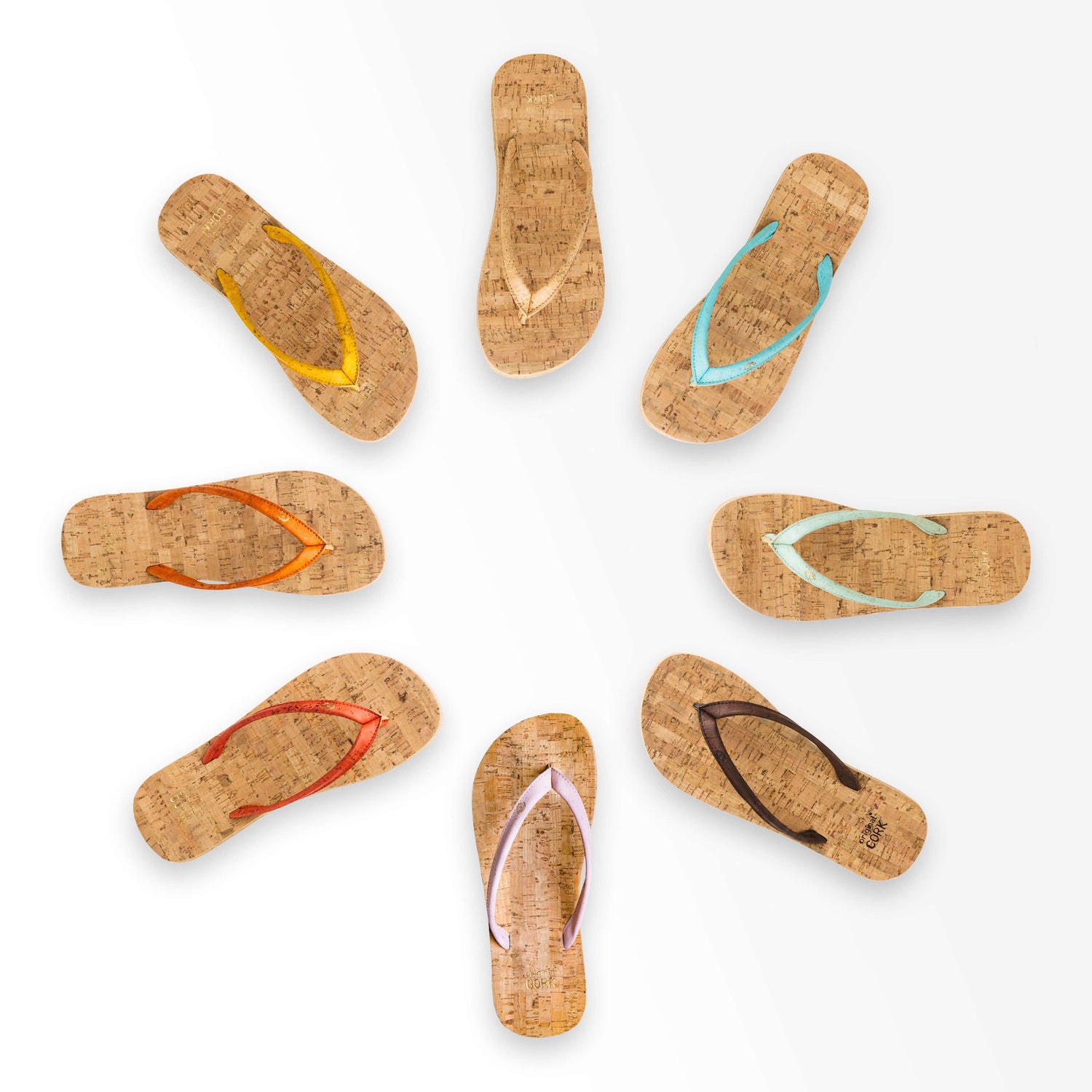3 CORK MYTHS - EXPOSED
In our journey creating our store, we've had the chance to talk to a lot of people about cork. Cork is still a rather misunderstood material outside of Portugal, where most cork grows and where cork is part of the country's culture. Most people's experience with cork is limited to cork stoppers in wine bottles and perhaps bulletin boards and coasters used underneath cold beverages. There are a lot of misconceptions that we have come across about what cork is and what goes into its harvest and its processing into cork products.
Education on raw textile materials is an imperative when it comes to pushing for a more sustainable global fashion industry, so I decided to take a few minutes today to address some of the major myths that surround cork in order to clear up any confusion. Let's dive in!
MYTH #1 - The Cork Oak is an endangered species, so by using cork, you're contributing to the decline of the cork forests.
This myth I have heard time and time again. In fact, one time when I was excited to see shoes in a store that were made with a cork sole, the salesperson advised me against buying them with a grave warning that cork was endangered.
Many people, in fact, think that there is a cork shortage, or cork is endangered and at risk of extinction.
The truth is that cork is not endangered in any way. However, this myth is so pervasive that some think that there is an effort to purposely spread this misinformation. It is possible that this is a myth created by the wine industry in order to convince wine drinkers that there are benefits to using screw caps instead of cork stoppers to seal wine bottles. Perhaps their thinking is that if they can convince customers that cork is endangered, more people might be willing to choose wine sealed with a screw cap. In reality, the only benefit to not using cork is to the profit margins of the wineries themselves, as authentic, quality cork stoppers cost more to use than plastic screw caps. But, naturally corked wine is still considered by most wine connoisseurs to be the best option, despite the propagation of this myth.
Perhaps the myth came from the fact that in 1923, the Portuguese government began to protect the cork tree by law from improper or out of season harvest. They did this because they were afraid that the cork forests would become prey to developers who would clear out the land for building. The government, in its mission to stop this from happening, named the cork oak as endangered. But, they were only able to call the tree “endangered” due to the over 200 species of wildlife that live in and depend on the cork oak forests for survival, many of which are endangered species themselves. (1)
According to Amorim, one of the largest cork manufacturers in the world, a recent estimate predicts that in Portugal alone, the country with the largest area of cork forests, that there is enough harvestable cork to meet the demands of the market for the next 100 years. (2)
What's more, harvesting of cork is a process that is carried out by skilled workers (some of the highest paid agricultural workers in the world) who carefully remove only the bark from the tree, leaving the tree healthy and intact. Harvesting the cork bark from the tree actually initiates a regeneration process of the tree, where it takes in more CO2 and produces more oxygen than normal. This process also extends the lifespan of the tree. It is the cork industry that maintains these forests by tending to the trees and stripping the bark every 9 years from each tree.
Cork harvesting, due to the above mentioned care involved in the process, is considered by the Forest Stewardship Council (FSC) to be one of the most sustainable forestry practices on the planet. In Portugal, 912 hectares of cork land in the Alentejo region are now FSC-certified, as well as 11.9 hectares in Andalucía, Spain, and 66 hectares in Sardinia, Italy. According to the World Wildlife Fund, “Cork oak landscapes are one of the best examples of balanced conservation and development anywhere in the world. They also play a key role in ecological processes such as water retention, soil conservation, and carbon storage.” (3)
MYTH EXPOSED: Cork is NOT endangered, and there is actually enough cork to meet market demand for the next hundred years.
MYTH #2: Cork products are low quality and have a "cheap" look to them.
When I started working with a respected social media blogger, the first thing that she told me was that she was honestly surprised by the quality of the cork products in our store when she saw them in person for the first time. This is no accident - we traveled through Portugal for months in order to do our research on cork fabric and to find the cork designers that are producing the highest quality bags and accessories out there. We have also seen a lot of cork products that do not match up to the quality of the bags and accessories made by the brands we carry in our store. They are made from a cork fabric of lower quality utilizing glues and fillers, with cheaper metal accents.
In addition, a discussion with one of our suppliers revealed that many people in Portugal have become disillusioned by the amount of cheaply made cork products out there, and even in Portugal people are surprised by the quality difference from one cork product to another.
We chose to work with the three brands whose products we carry in our store due to their impeccable standards and ethics in all steps of manufacturing. First off, they use cork that is extremely high quality, soft to the touch, and durable, in order to be sure that their products will last for years. They use hand-machining techniques so that each product is made by hand by an individual, with attention in every stitch. They also use only natural dyes to create colored cork options.
MYTH EXPOSED: The hand-made, in-house designs and artisan manufacturing techniques used by the brands we showcase in our store make all the difference and put our cork products in a league of their own.
MYTH #3: Cork cannot stand the test of time like leather
This myth seems to stem from simply the fact that most people at some point have owned a leather product such as a wallet or jacket, or at the very least probably seen or touched a leather product - leather is commonplace and people are accustomed to using it for clothing and accessories. On the other hand, cork is an innovative material in fashion that is new to many people. Most people have probably never seen a cork wallet or bag in person. Sometimes even if we don't realize it, habits can narrow our thinking patterns and make us cling to the old and reject the new simply because we are attached to the "old" and transitioning to the "new" can seem overwhelming or uncomfortable. In the case of cork the finished product is durable and long-lasting, with many of the same characteristics that can one would expect to find in animal leather. The great part about cork is that it holds up for many years like leather, looks just as aesthetically appealing (if not more, we think), and is made from renewable tree bark instead of animal hide. Working with cork does not pollute at any point in the circular zero-waste process going from raw material to finished product. Leather manufacturing on the other hand pollutes at practically every step of the process, and the water, air, and land become heavily contaminated in areas where it is produced.
Cork products stand the test of time due to the waxy interior substance found inside of cork's cellular structure. This waxy substance is called Suberin, and it makes cork material water-repellent and resistant to absorbing water into the core of the material. This means that cork does not allow moisture into its cells, which could cause degradation of the material, along with mold or mildew. It also allows for cork to be incredibly flexible, malleable, and durable. If cork leather becomes dirty on the surface, it can be quickly cleaned with a wet cloth and regains its original shine. Cork, like leather, builds character over time, and as it is used, it "breaks in" and becomes even more supple to the touch. We think each piece truly gains a personality of its own. Cork products, when properly cared for, can last 10-20 years, just like a leather bag or wallet.
MYTH EXPOSED: Cork leather holds up for the same average lifespan of an animal leather product without the need for destructive practices like those seen in the leather industry.
There you have it! Three cork myths - debunked. Are there any other myths about cork that you've heard? Let us know in the comments below.
Sources:
- “Cork Shortage- The Myth.” August 8 2017. https://queork.com/blogs/the-truth-about-cork/cork-shortage-the-myth
- “Cork Myths and Facts” Amorim. https://www.amorim.com/en/why-cork/myths-and-facts/Is-cork-an-endangered-natural-resource/108/117/#collapse117
- “Mediterranean Cork Forests Receive First Ever FSC Certification” http://wwf.panda.org/?21691/Mediterranean-cork-forests-receive-first-ever-FSC-certification
Photo credit: Cork Conservation Alliance


